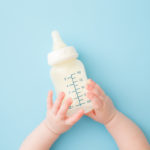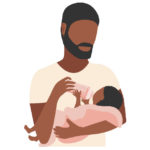
What can you do if your baby refuses to be bottle fed? This is a common question among mothers who want to stop breastfeeding altogether, or to supplement it. This transition may be complicated, so we must find a way to cause as little trauma as possible for both the parent and the child.
Keep in mind – anything new that interrupts a baby’s routine is often rejected.
Your doctor or other maternity expert may recommend that you give your baby bottle food just after one month after their birth. In this period, moms who work outside the home generally return to their jobs post-maternity leave, which is why they will not be available to breastfeed with the same frequency.
However, to wean your little one while they are so small can generate certain inconveniences. The best thing is to alternate breastfeeding with the use of the bottle so that baby receives the essential nutrients provided by breast milk, and complements them with the baby milks available in the market.
Adding formula milk to their diet progressively is important so that your baby gets used to it. This gradual approach will minimize the possibility of outright rejection.
Always remember that, in all cases, the process of changing your baby’s diet should be under the supervision of your pediatrician. They will help to indicate the appropriate formula and evaluate the possible reactions that may arise.
Why does my baby not want to be bottle fed?
Newborn babies demand a lot of physical contact with their mother. When they don’t have this contact, they may become stressed and cry. The closeness with their mom makes them feel protected and safe, so by making a change that minimizes in any measure the sacred moment of breast-feeding, they may feel rejection.
The novelty experienced in both the texture and the suction technique with a bottle is different from what is already familiar to baby; therefore, aversion is completely normal.
How does the sense of sight in children evolve?
Modifying your baby’s diet from breast milk to one of formula is a determining factor in the infant’s likelihood of repulsion by the bottle. Factors such as taste, texture or even the way their body reacts to this new food may make baby uncomfortable.
Because it is such a long and delicate process, patience plays a very important role. The little one will feel incomplete and strange when having new food, in addition to a new instrument with which to eat. Therefore, here are some suggestions to facilitate this transition:
Discovery
Let your child discover the bottle, take it in his hands and bite the nipple. This introduction will undoubtedly facilitate their adaptation. To have a higher percentage of success, add a few drops of breast milk; thus, he will associate that new object with his food.
Read Next | Is Breastfeeding Easier the Next Time Around?
Make him feel warm
When feeding, it is advisable to hug him and wrap him in a garment that retains the smell of his mother when she is not the one who will be giving him the bottle. You can talk to him in a low, quiet and loving tone so he feels safe.
Relax your baby during eating time
Having the baby in a good position and with gentle movements back and forth will turn the mealtime into a relaxing moment. The baby will therefore form a good association with the bottle.
Patience
Your baby may not accept or get used to the bottle overnight. Therefore, we must arm ourselves with patience and not force it if she cries or rejects it. Do not fall into despair of breastfeeding again at the slightest sign of rejection – the child’s acceptance and adaptation will vary and should be respected.
A good method to accelerate the acceptance of the bottle is that, instead of taking the nipple directly to your child’s mouth, place it close and rub it on the baby’s lips to take it whenever wanted. Always use the same bottle and techniques during feeding times in order to maintain consistency.
Temperature
The bottle temperature is very important; the milk should not be too cold or too hot. While there is no hard and fast temperature, you can check out this article about how to warm a baby bottle for guidelines.
In conclusion, weaning is a slow process that can produce many ups and downs. Have patience and don’t beat yourself up if you don’t have immediate success. Keep the above tips in mind and, as always, consult your pediatrician should you have any specific questions or concerns.
Maria writes for BebesyMadres.com, a Spanish language baby blog. She can be reached at [email protected].

Read Next | Baby Acne: Treatment and Causes
Like what you read? JOIN the Mommybites community to get the latest on FREE online classes, parenting advice, events, childcare listings, casting calls & raffles, and our Parents With Nannies Facebook group. SIGN UP NOW!



